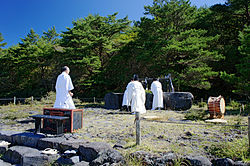
Back الدين في اليابان Arabic Yaponiyada din Azerbaijani জাপানের ধর্মবিশ্বাস Bengali/Bangla Náboženství v Japonsku Czech Religion in Japan German Religio en Japanio Esperanto Religión en Japón Spanish دین در ژاپن Persian Religion au Japon French जापान में धर्म Hindi
- Buddhism (46%)
- No religion (42%)
- Christianity (2%)
- Others (9%)
- Don't know / no response (1%)
- Shinto (48.6%)
- Buddhism (46.4%)
- Christianity (1.1%)
- Others (4%)


Religion in Japan is manifested primarily in Shinto and in Buddhism, the two main faiths, which Japanese people often practice simultaneously. Syncretic combinations of both, known generally as shinbutsu-shūgō, are common; they represented Japan's dominant religion before the rise of State Shinto in the 19th century.[3]
The Japanese concept of religion differs significantly from that of Western culture. Spirituality and worship are highly eclectic; rites and practices, often associated with well-being and worldly benefits, are of primary concern, while doctrines and beliefs garner minor attention.[4] Religious affiliation is an alien notion. Although the vast majority of Japanese citizens follow Shinto, only some 3% identify as Shinto in surveys, because the term is understood to imply membership of organized Shinto sects.[5][6] Some identify as "without religion" (無宗教, mushūkyō), yet this does not signify rejection or apathy towards faith. The mushūkyō is a specified identity, which is used mostly to affirm regular, "normal" religiosity while rejecting affiliation with distinct movements perceived as foreign or extreme.[7][8]
- ^ Evans, Jonathan; Cooperman, Alan; Starr, Kelsey Jo; Korichi, Manolo; Miner, William; Lesage, Kirsten (17 June 2024). "Religion and Spirituality in East Asian Societies". Pew Research Center.
- ^ "Japan". The World Factbook. Central Intelligence Agency. 21 May 2025.
- ^ Reischauer, Edwin O.; Jansen, Marius B. (1988). The Japanese today: change and continuity (2nd ed.). Belknap Press of Harvard University Press. p. 215. ISBN 978-0-674-47184-9.
- ^ Kisala, Robert. 2006. Japanese Religions. Pp. 3-13 in Nanzan Guide to Japanese Religions, ed. Paul L. Swanson and Clark Chilson. Honolulu: University of Hawaii Press.
- ^ Engler, Price. 2005. p. 95
- ^ Williams, 2004. pp. 4-5
- ^ Kawano, Satsuki. 2005. Ritual Practice in Modern Japan: Ordering Place, People, and Action. Honolulu: University of Hawaii Press.
- ^ LeFebvre, J. (2015). "Christian wedding ceremonies: 'Nonreligiousness' in contemporary Japan". Japanese Journal of Religious Studies, 42(2), 185-203